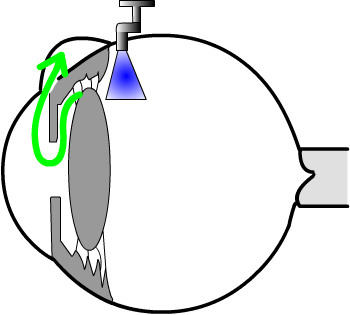Trabeculectomy is well described here, here , This
page just has a few notes, with an animation here.Leaflet
Trabeculectomy.
Some wonderful videos and other information here
The pages above describe
the operation, but there are important details to remember.the operation
creates a valve that leads fluid out of your eye. If this valve blocks
as part of the healling process, anti-healing treatment to open the valve
up is often needed. This will help to stop closing again. The anti-healing
treatment often has to be repeated.
-
nearly all patients need antihealing treatment.
-
after the operation your sight may not be quite
as clear, and there are risks as described on the pages with links
above;
-
the operation is just the first stage; for instance
-
the first day after your operation, if the
pressure is very low, the steroid drops are stopped for a few days.
For instance, if the 'AC' is deep, and the pressure 0, stop drops
for 2 days (as an example).
-
1-2 weeks after the operation, if the pressure is >14mmHg, you
usually need the releasable suture releasing
-
a pressure of 10-14 is ideal at this stage
(severe glaucoma needs a lower pressure)
-
patients are often seen every week for a
while to ensure the presure stays at this required level
-
in the days after the operation patients
with too much leak and a shallow anterior chamber may need further
surgery to seal the leak.
-
after the operation, steroid drops, antibiotic drops, and drops to
dilate the pupil are often needed.
-
always bring the drops with you to the clinic, as the dose will be
adjusted etc
-
in the weeks after the operation, if the wound
becomes very red extra steroid drops may be needed (the redness is
a sign of an over-active healing process)
-
if the pressure rises, anti-healing injections
will be offered
-
you should not go on holiday abroad for 3 months after your operation
(advice changes depending on how severe the glaucoma is, etc)
-
some ophthalmologists recommend no swimming after
the operation in the years after surgery, but others feel swimming
is safe once the eye has recovered after the operation (accepting there
is a very small risk of problems, but that the benefits outweigh the
risks)
|
